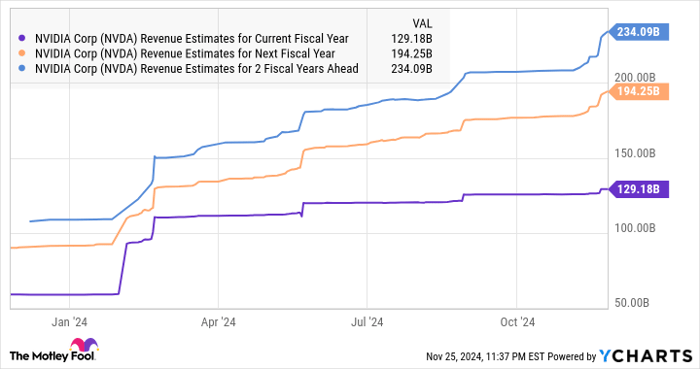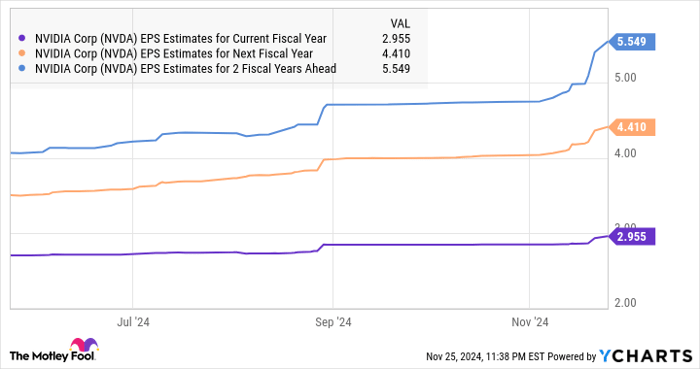The past two years have been absolutely phenomenal for Nvidia (NASDAQ: NVDA) investors, as shares of the graphics card specialist shot up 736% during this period once it became evident that the company is going to play a central role in the proliferation of artificial intelligence (AI).
Nvidia's stellar returns can be justified by the rapid growth in its revenue and earnings during this period, a result of its monopoly-like position in the AI chip market. The good part is that Nvidia seems capable of sustaining its stunning rally over the next three years as well, especially after the comments that management made on the company's recent earnings conference call.
Let's look at the reasons why Nvidia investors can expect this high-flying semiconductor stock to deliver more upside.
Nvidia is making the right moves to capitalize on the massive demand for its chips
When Nvidia released its fiscal 2025 third-quarter results (for the three months ended Oct. 27) on Nov. 20, it reported record revenue of $35.1 billion. The company's top line increased 94% year over year, driven mainly by the 112% spike in its data center revenue to $30.8 billion.
Nvidia was originally anticipating fiscal Q3 revenue to land at $32.5 billion, but it cruised past that estimate thanks to the aggressive production ramp of its next-generation Blackwell processors. The company is witnessing "staggering demand" for its Blackwell AI chips, which is why it is "racing to scale supply."
It is not surprising to see why Blackwell's demand is so solid. After all, recent tests indicate that Nvidia's latest generation of AI processors can deliver a 2.2x jump in performance over the previous generation of Hopper chips. What's more, this terrific improvement in performance is accompanied by a drop in computing costs. As pointed out by CFO Colette Kress:
The 64 Blackwell GPUs are required to run the GPT-3 benchmark compared to 256 H100s or a 4x reduction in cost.
So, Nvidia is doing the right thing by increasing the output of its Blackwell processors, even though it is taking a short-term margin hit in the process. The company expects its non-GAAP (adjusted) gross margin to land at 73.5% in the current quarter, which will be a drop from the year-ago period's reading of 76.7%. However, Kress points out that Nvidia's gross margin will grow back into the mid-70s range once the production of the Blackwell processors fully ramps up.
Japanese investment bank Mizuho recently raised Nvidia's GPU sales estimate for 2025 by 10% to 30 million units, citing the rising demand for these chips in gaming, data centers, and AI. This explains why consensus estimates are now projecting strong growth from Nvidia in fiscal years 2025 and 2026.
NVDA Revenue Estimates for Current Fiscal Year data by YCharts
The product roadmap could help the stock deliver impressive gains over the next three years
One key reason why Nvidia has been able to maintain a terrific grip over the GPU market is because of the technological advantage that it enjoys over rivals. The likes of AMD have been playing catch up, and Nvidia has left competitors in the dust by capturing the lion's share of the AI chip space. The good part is that Nvidia has an aggressive product roadmap that could help it sustain its dominance in this lucrative space.
For instance, Nvidia's Blackwell processors will be succeeded by chips based on the Rubin architecture in the first half of 2026. Analysts estimate that Nvidia will manufacture the Rubin chips using a 3-nanometer (nm) process node from Taiwan Semiconductor Manufacturing. That would be an improvement over the Blackwell's 4NP process node, which is an enhanced version of TSMC's 5nm process.
A smaller process node means that Nvidia will be able to pack more transistors into a compact area, which ideally leads to an improvement in computing power and a reduction in power consumption. So, it won't be surprising to see Rubin helping Nvidia maintain its technological advantage over rivals in the AI chip market and help it sustain its terrific pricing power in this space.
With the market for AI chips expected to generate a whopping $500 billion in revenue in 2028, according to AMD, Nvidia's dominance of this market is likely to lead to robust top and bottom-line growth. That explains why analysts have raised their growth expectations from the company for the current and next fiscal year, as seen earlier.
A similar trend can be seen for fiscal 2027 (which will coincide with the majority of its calendar year 2026).
NVDA EPS Estimates for Current Fiscal Year data by YCharts
The chart above shows that analysts are expecting Nvidia to deliver $5.55 per share in earnings in fiscal 2027. Assuming that the company trades at 40.8 times earnings at that time (in line with its five-year average forward earnings multiple), its stock price could hit $226 in a couple of years. That would be a 67% jump from current levels.
Given that Nvidia is now trading at 36 times forward earnings, investors can buy this AI stock at an attractive valuation right now, and they may not want to miss this opportunity as the company could deliver stronger gains if the market decides to reward its handsome growth with a richer multiple.
Should you invest $1,000 in Nvidia right now?
Before you buy stock in Nvidia, consider this:
The Motley Fool Stock Advisor analyst team just identified what they believe are the 10 best stocks for investors to buy now… and Nvidia wasn’t one of them. The 10 stocks that made the cut could produce monster returns in the coming years.
Consider when Nvidia made this list on April 15, 2005... if you invested $1,000 at the time of our recommendation, you’d have $829,378!*
Stock Advisor provides investors with an easy-to-follow blueprint for success, including guidance on building a portfolio, regular updates from analysts, and two new stock picks each month. The Stock Advisor service has more than quadrupled the return of S&P 500 since 2002*.
*Stock Advisor returns as of November 25, 2024
Harsh Chauhan has no position in any of the stocks mentioned. The Motley Fool has positions in and recommends Advanced Micro Devices, Nvidia, and Taiwan Semiconductor Manufacturing. The Motley Fool has a disclosure policy.
The views and opinions expressed herein are the views and opinions of the author and do not necessarily reflect those of Nasdaq, Inc.




